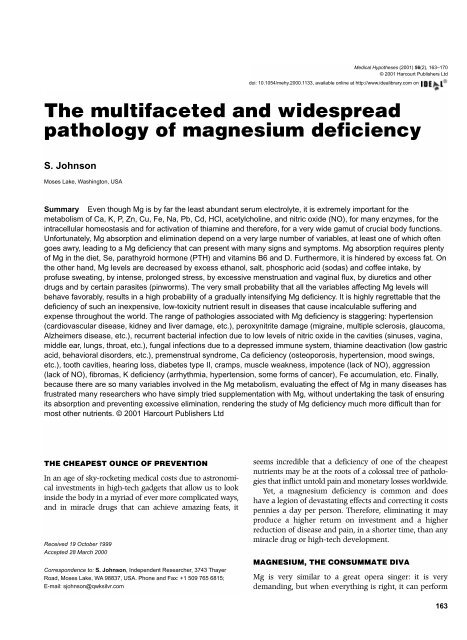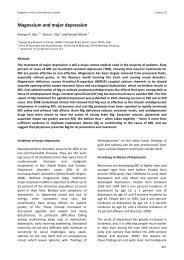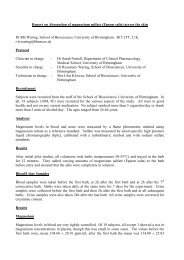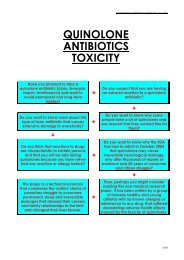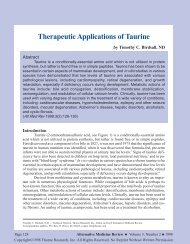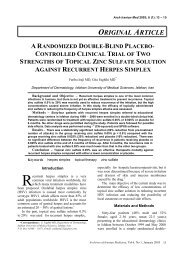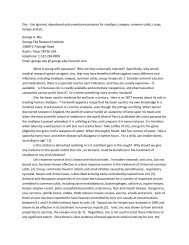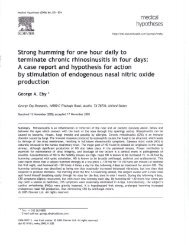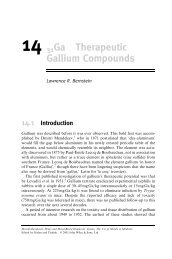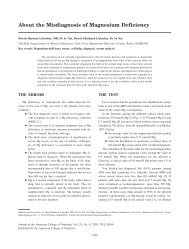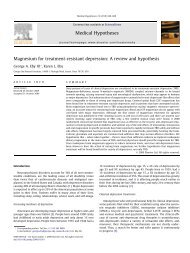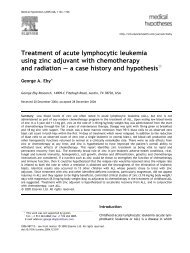The multifaceted and widespread pathology of magnesium deficiency
The multifaceted and widespread pathology of magnesium deficiency
The multifaceted and widespread pathology of magnesium deficiency
You also want an ePaper? Increase the reach of your titles
YUMPU automatically turns print PDFs into web optimized ePapers that Google loves.
<strong>The</strong> <strong>multifaceted</strong> <strong>and</strong> <strong>widespread</strong><br />
<strong>pathology</strong> <strong>of</strong> <strong>magnesium</strong> <strong>deficiency</strong><br />
S. Johnson<br />
Moses Lake, Washington, USA<br />
Summary Even though Mg is by far the least abundant serum electrolyte, it is extremely important for the<br />
metabolism <strong>of</strong> Ca, K, P, Zn, Cu, Fe, Na, Pb, Cd, HCl, acetylcholine, <strong>and</strong> nitric oxide (NO), for many enzymes, for the<br />
intracellular homeostasis <strong>and</strong> for activation <strong>of</strong> thiamine <strong>and</strong> therefore, for a very wide gamut <strong>of</strong> crucial body functions.<br />
Unfortunately, Mg absorption <strong>and</strong> elimination depend on a very large number <strong>of</strong> variables, at least one <strong>of</strong> which <strong>of</strong>ten<br />
goes awry, leading to a Mg <strong>deficiency</strong> that can present with many signs <strong>and</strong> symptoms. Mg absorption requires plenty<br />
<strong>of</strong> Mg in the diet, Se, parathyroid hormone (PTH) <strong>and</strong> vitamins B6 <strong>and</strong> D. Furthermore, it is hindered by excess fat. On<br />
the other h<strong>and</strong>, Mg levels are decreased by excess ethanol, salt, phosphoric acid (sodas) <strong>and</strong> c<strong>of</strong>fee intake, by<br />
pr<strong>of</strong>use sweating, by intense, prolonged stress, by excessive menstruation <strong>and</strong> vaginal flux, by diuretics <strong>and</strong> other<br />
drugs <strong>and</strong> by certain parasites (pinworms). <strong>The</strong> very small probability that all the variables affecting Mg levels will<br />
behave favorably, results in a high probability <strong>of</strong> a gradually intensifying Mg <strong>deficiency</strong>. It is highly regrettable that the<br />
<strong>deficiency</strong> <strong>of</strong> such an inexpensive, low-toxicity nutrient result in diseases that cause incalculable suffering <strong>and</strong><br />
expense throughout the world. <strong>The</strong> range <strong>of</strong> pathologies associated with Mg <strong>deficiency</strong> is staggering: hypertension<br />
(cardiovascular disease, kidney <strong>and</strong> liver damage, etc.), peroxynitrite damage (migraine, multiple sclerosis, glaucoma,<br />
Alzheimers disease, etc.), recurrent bacterial infection due to low levels <strong>of</strong> nitric oxide in the cavities (sinuses, vagina,<br />
middle ear, lungs, throat, etc.), fungal infections due to a depressed immune system, thiamine deactivation (low gastric<br />
acid, behavioral disorders, etc.), premenstrual syndrome, Ca <strong>deficiency</strong> (osteoporosis, hypertension, mood swings,<br />
etc.), tooth cavities, hearing loss, diabetes type II, cramps, muscle weakness, impotence (lack <strong>of</strong> NO), aggression<br />
(lack <strong>of</strong> NO), fibromas, K <strong>deficiency</strong> (arrhythmia, hypertension, some forms <strong>of</strong> cancer), Fe accumulation, etc. Finally,<br />
because there are so many variables involved in the Mg metabolism, evaluating the effect <strong>of</strong> Mg in many diseases has<br />
frustrated many researchers who have simply tried supplementation with Mg, without undertaking the task <strong>of</strong> ensuring<br />
its absorption <strong>and</strong> preventing excessive elimination, rendering the study <strong>of</strong> Mg <strong>deficiency</strong> much more difficult than for<br />
most other nutrients. © 2001 Harcourt Publishers Ltd<br />
THE CHEAPEST OUNCE OF PREVENTION<br />
In an age <strong>of</strong> sky-rocketing medical costs due to astronomical<br />
investments in high-tech gadgets that allow us to look<br />
inside the body in a myriad <strong>of</strong> ever more complicated ways,<br />
<strong>and</strong> in miracle drugs that can achieve amazing feats, it<br />
Received 19 October 1999<br />
Accepted 28 March 2000<br />
Correspondence to: S. Johnson, Independent Researcher, 3743 Thayer<br />
Road, Moses Lake, WA 98837, USA. Phone <strong>and</strong> Fax: +1 509 765 6815;<br />
E-mail: sjohnson@qwksilvr.com<br />
Medical Hypotheses (2001) 56(2), 163–170<br />
© 2001 Harcourt Publishers Ltd<br />
doi: 10.1054/mehy.2000.1133, available online at http://www.idealibrary.com on<br />
seems incredible that a <strong>deficiency</strong> <strong>of</strong> one <strong>of</strong> the cheapest<br />
nutrients may be at the roots <strong>of</strong> a colossal tree <strong>of</strong> pathologies<br />
that inflict untold pain <strong>and</strong> monetary losses worldwide.<br />
Yet, a <strong>magnesium</strong> <strong>deficiency</strong> is common <strong>and</strong> does<br />
have a legion <strong>of</strong> devastating effects <strong>and</strong> correcting it costs<br />
pennies a day per person. <strong>The</strong>refore, eliminating it may<br />
produce a higher return on investment <strong>and</strong> a higher<br />
reduction <strong>of</strong> disease <strong>and</strong> pain, in a shorter time, than any<br />
miracle drug or high-tech development.<br />
MAGNESIUM, THE CONSUMMATE DIVA<br />
Mg is very similar to a great opera singer: it is very<br />
dem<strong>and</strong>ing, but when everything is right, it can perform<br />
163
164 Johnson<br />
wonders. It is dem<strong>and</strong>ing in that its absorption requires a<br />
host <strong>of</strong> conditions <strong>and</strong> is inhibited by several factors.<br />
Moreover, Mg will leave the body, without hesitation, if<br />
any <strong>of</strong> a series <strong>of</strong> conditions are not met.<br />
ENTICING THE DIVA<br />
In contrast to Ca, which requires either parathyroid hormone<br />
(PTH) or vitamin D for its absorption, Mg requires<br />
both PTH <strong>and</strong> vitamin D (1,2). <strong>The</strong>refore, we can say that<br />
the main function <strong>of</strong> vitamin D in a euparathyroid person<br />
is not Ca but Mg absorption.<br />
Since vitamin D must either be produced by exposure<br />
to sunlight or ingested in the few foods that contain it<br />
(vitamin D enriched milk, cod liver oil, etc), it can be seen<br />
that people with limited exposure to sunlight <strong>and</strong> without<br />
access to food rich in vitamin D are likely to suffer<br />
from a Mg <strong>deficiency</strong>. Similarly, severely hypoparathyroid<br />
individuals would automatically be deficient in Mg.<br />
Furthermore, a small amount <strong>of</strong> Mg is indispensable for<br />
the release <strong>of</strong> PTH, <strong>and</strong> since PTH is necessary for Mg<br />
uptake, when very low levels <strong>of</strong> Mg are reached, PTH is<br />
not released <strong>and</strong> Mg levels can no longer recover, unless<br />
a small amount <strong>of</strong> Mg is administered intravenously, in<br />
order to prime the release <strong>of</strong> PTH.<br />
Finally, a diet rich in saturated fats <strong>and</strong>/or low in vitamin<br />
B6 hinders Mg absorption. Unfortunately, the modern<br />
American diet: hamburgers, French fries, c<strong>of</strong>fee <strong>and</strong> sodas is<br />
not only relatively low in Mg, it is very rich in saturated<br />
fats, which hinder its absorption <strong>and</strong>, as we shall see<br />
next, c<strong>of</strong>fee <strong>and</strong> phosphoric acid (sodas) increase Mg<br />
elimination.<br />
HOLDING ON TO THE DIVA<br />
Many substances increase renal elimination <strong>of</strong> Mg, when<br />
consumed in excess: ethanol, diuretics, c<strong>of</strong>fee, tea, salt,<br />
phosphoric acid (sodas), Ca, K <strong>and</strong> sugar as can many<br />
drugs, foscarnet (a Mg chelator), aminoglycosides, amphotericin<br />
B, cyclosporine, azathioprine, cisplatin, citrated<br />
blood, excess vitamin D, etc. (see Fig. 1).<br />
Serum Mg levels may also decrease suddenly, when<br />
the Mg enters the cells because <strong>of</strong> alcohol withdrawal,<br />
hungry bone syndrome or refeeding syndrome after starvation<br />
(3). Delirium tremens is caused partly by very low<br />
serum levels <strong>of</strong> glucose, Mg, P <strong>and</strong> B vitamins. Mg greatly<br />
affects muscle by inhibiting the release <strong>of</strong> acetylcholine,<br />
the neurotransmitter that triggers muscle contraction (4).<br />
Accordingly, in delirium tremens, the low levels <strong>of</strong> Mg<br />
increase the release <strong>of</strong> acetylcholine, producing massive<br />
involuntary contractions.<br />
Furthermore, prolonged, intense stress, especially in<br />
the absence <strong>of</strong> Mg-rich foods <strong>and</strong> sun light, increases<br />
considerably Mg elimination (<strong>and</strong> therefore, Ca <strong>and</strong> K<br />
elimination). <strong>The</strong> extreme case being the shell-shock<br />
inflicted on thous<strong>and</strong>s during the repeated <strong>and</strong> prolonged<br />
bombardments <strong>of</strong> WW I.<br />
Several conditions can also increase Mg elimination (3):<br />
prolonged diarrhea or vomiting, biliary fistulas, chronic<br />
pancreatic insufficiency, acute tubular necrosis (diuretic<br />
phase), aldosteronism, diabetic ketoacidosis, syndrome <strong>of</strong><br />
inappropriate antidiuretic hormone following renal transplantation<br />
(the hormonally induced Mg losses are exacerbated<br />
by the administration <strong>of</strong> cyclosporine, which we<br />
listed above as contributing to Mg elimination).<br />
Moreover, a Se <strong>deficiency</strong> also increases Mg elimination<br />
<strong>and</strong> causes Fe accumulation (5).<br />
Very heavy menstruation, vaginal flux or sweating also<br />
increase Mg elimination. Some parasites, such as the<br />
quite common pinworm (Enterobius vermiculares), can<br />
deprive the body <strong>of</strong> Mg (6).<br />
Finally, insufficient water intake, a very common phenomenon,<br />
has the same effect as high sodium intake,<br />
causing increased elimination <strong>of</strong> Mg, in order to increase<br />
the salinity <strong>of</strong> the urine.<br />
THE ENIGMATIC DIVA<br />
Because there are so many variables involved in Mg<br />
absorption <strong>and</strong> elimination, it is very difficult to study the<br />
effect <strong>of</strong> Mg supplementation in clinical trials, in which<br />
only Mg is administered. So that a person with minimal<br />
exposure to sunlight or a fat-rich diet or enterobiosis or<br />
high ethanol consumption or under considerable stress,<br />
receiving 100 mg <strong>of</strong> Mg may experience a minimal effect,<br />
while the rare person in which all the variables are favorable,<br />
may experience a considerable effect. Since most<br />
people are much more likely to have at least one faulty<br />
variable than they are to have all the variables operating<br />
favorably, the clinical study would conclude that Mg has<br />
no noticeable effect on the condition.<br />
THE DIVERSE PATHOLOGY OF MG DEFICIENCY<br />
Mg is far smaller, less electropositive <strong>and</strong> less abundant in<br />
serum than Na, Ca or K <strong>and</strong> it plays a myriad crucial roles<br />
in electrolyte, hormonal <strong>and</strong> enzymatic homeostasis with<br />
an extremely wide range <strong>of</strong> repercussions throughout the<br />
body.<br />
Diseases caused by electrolyte imbalances<br />
Mg is necessary for activation <strong>of</strong> most <strong>of</strong> the ATPases, so<br />
that low Mg levels result in impaired transport <strong>of</strong> K, H,<br />
Na, Ca, etc.<br />
Because the kidneys require Mg in order to recycle Ca,<br />
P <strong>and</strong> K <strong>and</strong> to eliminate excess Na, Cl, Pb <strong>and</strong> Cd. A Mg<br />
<strong>deficiency</strong> eventually leads to low levels <strong>of</strong> Ca <strong>and</strong> K <strong>and</strong><br />
to high levels <strong>of</strong> Na, Cl, Cd <strong>and</strong> Pb. This electrolytic<br />
imbalance leads to hypertension <strong>and</strong> to intracellular<br />
Medical Hypotheses (2001) 56(2), 163–170 © 2001 Harcourt Publishers Ltd
DISEASE: Hypoparathyroidism, large burns (including severe sunburns), prolonged diarrhea or<br />
vomiting (including bulimia nervosa), hypophosphatemia, hypokalemia, chroni pancreatic<br />
insufficiency, metabolic acidosis, celiac disease, biliary fistulas, acute tubular necrosis,<br />
diabetic ketoacidosis, Crohn's disease, ulcerative colitis, disturbances in the calcitonin, renin<br />
or glucagon metabolisms, hyperaldesteronism (Conn's syndrome), anorexia nervosa,<br />
steatorrhea, thyrotoxicosis, Zn <strong>deficiency</strong>, etc,<br />
EXCESS: alcohol, c<strong>of</strong>fee, tea,<br />
phosphoric acid (sodas),<br />
carbonic acid (sodas), salt,<br />
sugar, Ca, K, Cu, Fe, protein<br />
or purines, Cow's milk<br />
in infants (causes<br />
hyperphophatemia because it<br />
contains more P than<br />
human milk), nitrate in water,<br />
etc.<br />
Low Se or<br />
water<br />
Intense, prolonged<br />
stress<br />
Excess estrogen,<br />
low progesterone<br />
(high Cu, low Zn)<br />
Increased Mg elimination<br />
Low PTH<br />
Mg <strong>deficiency</strong><br />
disturbances at the mitochondrial level. In turn, the<br />
hypertension eventually leads to cardiovascular damage,<br />
renal <strong>and</strong> hepatic damage, increased risk <strong>of</strong> aneurysms<br />
<strong>and</strong> internal hemorrhages, <strong>and</strong> many other diseases.<br />
Hypertension is further exacerbated by low Mg <strong>and</strong><br />
vitamin B6 levels in hypercholesterolemia, because they<br />
DRUGS: Loop diuretics, foscarnet, azathioprine,<br />
cyclosporine, aminoglycosides, amphotericin B, cisplatin,<br />
citrated blood, lithium carbonate, betablockers,<br />
corticosteroids, vitamin D intoxication, aluminum laxatives<br />
antacids that cause hypophosphatemia, prednisone,<br />
prolonged intake <strong>of</strong> 20g vitamin C/day, etc<br />
Cd, Pb,<br />
Al<br />
Low Mg in diet<br />
Low stomach pH Thiamine<br />
<strong>deficiency</strong><br />
Magnesium <strong>deficiency</strong> 165<br />
Excess Ca. or K<br />
Lack <strong>of</strong> sunlight<br />
Vit D <strong>deficiency</strong><br />
LIVER DISEASE that<br />
precludes vit D synthesis or<br />
storage (cirrhosis,<br />
hemochromatosis, Wilson's<br />
Mg DEPLETING PARASITES (Enterbius vermicularis,<br />
viral, fungal or bacterial infectious agents that cause<br />
<strong>widespread</strong> tissue death, etc,)<br />
CANCER cells require large amounts <strong>of</strong> Mg to support<br />
their very high rate <strong>of</strong> DNA <strong>and</strong> protein synthesis, depriving immune<br />
<strong>and</strong> other healthy cells <strong>of</strong> Mg (they do the same with Zn, P <strong>and</strong><br />
other nutrients)<br />
INCREASED Mg DEMAND: Prolonged, intense sweating, prolonged internal hemorrhage,<br />
acute hemorrhage, serial phlebotomy (though serum is low in Mg, blood cells are not),<br />
pregnancy (eclampsia is the extreme case), massive tissue damage, etc.<br />
Fig. 1 <strong>The</strong> multiple factors conspiring to produce a Mg <strong>deficiency</strong>.<br />
Excess<br />
saturated<br />
fat in diet<br />
Reduced Mg absorption<br />
result in diminished endothelial cell response to the<br />
vasodilators histamine <strong>and</strong> acetylcholine <strong>and</strong> increased<br />
response to the vasoconstrictors 5-hydroxytriptamine,<br />
angiotension <strong>and</strong> noradrenaline, leading to atherosclerosis.<br />
<strong>The</strong> abnormal response to these vasodilators <strong>and</strong><br />
vasoconstrictors can be corrected with <strong>magnesium</strong><br />
© 2001 Harcourt Publishers Ltd Medical Hypotheses (2001) 56(2), 163–170
166 Johnson<br />
pyridoxal 5-phosphate glutamate (7). <strong>The</strong> guilt <strong>of</strong> Mg in<br />
coronary atherosclerosis <strong>and</strong> hypertension is supported<br />
by epidemiological data from apparently healthy individuals<br />
(8) <strong>and</strong> from renal transplant patients, who experience<br />
Mg <strong>deficiency</strong> induced by cyclosporine (9).<br />
Diseases caused by inactive thiamine<br />
Thiamine (vitamin B1) forms thiamine pyrophosphate in<br />
the presence <strong>of</strong> Mg. When the latter is not available, thiamine<br />
cannot perform properly (10) (see Fig. 4). <strong>The</strong><br />
result is an apparent thiamine <strong>deficiency</strong>, even when the<br />
body has enough or excess thiamine. <strong>The</strong> lack <strong>of</strong> performance<br />
<strong>of</strong> thiamine results in low levels <strong>of</strong> gastric acid<br />
(low levels <strong>of</strong> secretin, leading to autism), leading to<br />
Impaired Zn enzyme activity (RNA polymerase, etc.)<br />
impaired protein <strong>and</strong><br />
DNA synthesis<br />
Low serotonin<br />
depression<br />
stress<br />
Mg <strong>deficiency</strong><br />
insomnia<br />
Low PTH<br />
Low calcitonin<br />
Low vit D<br />
Hypertension<br />
Decreased renal resorption <strong>of</strong> K<br />
Depressed immunity, increased bacterial infection risk<br />
Reduced extracellular NO levels Hyperactive osteoclasts<br />
Fig. 2 Interaction between Mg, Ca, Zn <strong>and</strong> K.<br />
Low serotonin<br />
increased risk <strong>of</strong> GI infections <strong>and</strong> to impaired digestion<br />
<strong>and</strong> in damage to the hypothalamus (confusion,<br />
delusions, hallucinations, disorientation, Wernicke’s<br />
encephalopathy (11), Alzheimer’s disease, etc.). <strong>The</strong> lack<br />
<strong>of</strong> Mg also leads to the formation <strong>of</strong> calcium pyrophosphate,<br />
instead <strong>of</strong> thiamine pyrophosphate. Calcium<br />
pyrophosphate can precipitate in painful crystals<br />
(pseudogout).<br />
Diseases caused by faulty NO release from the cells<br />
Magnesium also plays a crucial role in the release <strong>of</strong> nitric<br />
oxide (NO) from the cell. NO serves many functions (see<br />
Figs 2, 3 <strong>and</strong> 6), among the most important is preventing<br />
Zn <strong>deficiency</strong><br />
Excess Ca<br />
Ca <strong>and</strong> P<br />
<strong>deficiency</strong><br />
K <strong>deficiency</strong><br />
Reduced<br />
bone<br />
mass<br />
Stunted growth<br />
osteoporosis<br />
Rickets<br />
Chronic<br />
cholestasis<br />
Medical Hypotheses (2001) 56(2), 163–170 © 2001 Harcourt Publishers Ltd
Myelin<br />
degeneration<br />
Oxidative<br />
damage<br />
infections in the body cavities, such as the sinuses, throat,<br />
lungs, vagina, larynx, etc.<br />
Another mayor function <strong>of</strong> NO is vasodilatation,<br />
which is the reason for administering nitroglycerin to a<br />
stroke patient.<br />
NO, vitamin K, Mg <strong>and</strong> Sr inhibit the osteoclasts (12),<br />
greatly increasing bone deposition. <strong>The</strong>refore, Mg greatly<br />
affects osteoporosis by increasing Ca serum levels <strong>and</strong><br />
by inhibiting bone removal by the osteoclasts, which are<br />
inactivated both by Mg <strong>and</strong> by NO released thanks to<br />
Mg.<br />
NO <strong>deficiency</strong> may also play a role in arteriosclerosis<br />
induced by low Mg levels, since Chlamydia p, is<br />
Deficiency <strong>of</strong> vitamin B2 (a c<strong>of</strong>actor for XO)<br />
hypourecemia Underactive xanthine oxidase<br />
Excess Cu<br />
Migraines,<br />
Ravnaud's disease<br />
Reduced<br />
perfusion<br />
Excess oxidation<br />
<strong>of</strong> vitamin C<br />
H 2 O 2 , hydroxyl<br />
Peroxinitrite<br />
Hyperactive acetylcholine<br />
Myasthenia gravis<br />
Multiple slerosis<br />
Superoxide<br />
High intracellular NO<br />
Reduced oligodendrocyte myelin synthesis<br />
Pimary biliary cirrhosis,<br />
rhematoid arthritis <strong>and</strong> lupus<br />
Mg <strong>deficiency</strong><br />
Low extracellular NO<br />
Recurrent infection<br />
Fig. 3 Combined Mg <strong>and</strong> Zn <strong>deficiency</strong> <strong>and</strong> excess Cu in menstruating women.<br />
Excess calories<br />
cause the mitochondria<br />
to<br />
produce super<br />
oxide<br />
Excess<br />
estrogen<br />
Low CuZnSOD<br />
Zn <strong>deficiency</strong><br />
Low levels <strong>of</strong><br />
progesterone,<br />
serotonin,<br />
melatonin <strong>and</strong><br />
testosterone<br />
PMS, increased appetite, sleeplessness,<br />
depression, aggression, loss <strong>of</strong> libido,<br />
tender breasts<br />
Low levels <strong>of</strong> the enzymes involved in cartilage repair<br />
Magnesium <strong>deficiency</strong> 167<br />
suspected <strong>of</strong> contributing this disease, <strong>and</strong> low NO levels<br />
may favor this bacterium.<br />
Since Mg is necessary to activate thiamine in order to<br />
prevent excessive aggression <strong>and</strong> since Mg is also necessary<br />
for the neurons to release NO, which also plays a role<br />
in aggression in males, it is obvious that a Mg <strong>deficiency</strong><br />
should be considered as part <strong>of</strong> the etiology <strong>of</strong> highly<br />
aggressive behavior in males by psychiatrists. On the<br />
other h<strong>and</strong>, Mg <strong>deficiency</strong> in females is <strong>of</strong>ten part <strong>of</strong> the<br />
etiology <strong>of</strong> depression.<br />
When Mg is deficient, the cell cannot release its NO,<br />
so that the bacteria can thrive <strong>and</strong> blood vessels cannot<br />
dilate properly, resulting in increased risk <strong>of</strong> recurring<br />
© 2001 Harcourt Publishers Ltd Medical Hypotheses (2001) 56(2), 163–170
168 Johnson<br />
Thiamine pyrophosphate does not form<br />
Ca pyrophosphate<br />
pseudogout<br />
Secretin <strong>deficiency</strong><br />
Autism<br />
Mg <strong>deficiency</strong><br />
Gastric acid <strong>deficiency</strong><br />
Increased gastrointestinal<br />
infection risk<br />
Inense stress, anxiety<br />
Intense stress, anxiety<br />
Fig. 4 <strong>The</strong> pathologic effects <strong>of</strong> a Mg <strong>deficiency</strong> on the thiamine metabolism.<br />
Low PTH Mg <strong>deficiency</strong><br />
Increased Ca<br />
<strong>and</strong> K renal<br />
elimination<br />
Ca <strong>and</strong> K<br />
<strong>deficiency</strong><br />
Ticks <strong>and</strong> cramps<br />
Excess acetylcholine<br />
Uncontrollable muscle contraction<br />
Delirium tremens<br />
Fig. 5 Mg <strong>and</strong> acetylcholine release in skeletal muscle.<br />
Low glucose, P, vitamin B complex<br />
infection <strong>and</strong> exacerbating the hypertension caused by<br />
the low plasma levels <strong>of</strong> Ca <strong>and</strong> Mg <strong>and</strong> high levels <strong>of</strong><br />
Na. Furthermore, the accumulation <strong>of</strong> NO in the cell<br />
causes formation <strong>of</strong> peroxynitrite, an extremely reactive<br />
substance formed by the reaction <strong>of</strong> NO with<br />
superoxide, which causes massive oxidative damage to<br />
the cell.<br />
<strong>The</strong> combination <strong>of</strong> hypertension, impaired perfusion,<br />
<strong>and</strong> cellular damage leads to migraines (13), multiple<br />
sclerosis, impotence (NO causes the vasodilation<br />
Low extracellular No,<br />
high intracellular NO<br />
pronounced aggression<br />
in males<br />
Tourette's<br />
syndrome<br />
responsible for an erection), glaucoma, strokes, etc. (see<br />
Fig. 6).<br />
Diseases due to excess acetylcholine release at the<br />
neuro-muscular junction, by deficient Mg<br />
As we mentioned above, Mg inhibits the release <strong>of</strong> acetylcholine,<br />
so that low Mg levels lead to uncontrollable muscle<br />
contractions (see Fig. 6). This can be seen in delirium<br />
tremens, myasthenia gravis, Guillain-Barre syndrome, etc.<br />
Medical Hypotheses (2001) 56(2), 163–170 © 2001 Harcourt Publishers Ltd<br />
ADD<br />
Depressed immune<br />
system, hepertension,<br />
impaired perfusion,<br />
cellular<br />
nutrition <strong>and</strong> mental<br />
concentration<br />
Fe accumulation<br />
Myasthenia gravis<br />
Parkinsonism<br />
Oxidative damage<br />
to doparminergic cells<br />
Tourette's
Kidney damage, UA stones<br />
hypertension, gout, etc.<br />
Vasoconstriction,<br />
Reduced perfusion<br />
Diseases due to trace metal accumulation, caused by<br />
deficient Mg<br />
A Mg <strong>deficiency</strong> affects greatly the distribution <strong>of</strong> several<br />
minerals in the body, for example, it increases Fe levels in<br />
liver, spleen <strong>and</strong> kidney at the same time that it reduces<br />
Cu levels in the liver (14).<br />
Increased uric acid production Overactive<br />
xanthine<br />
oxidase<br />
Increased superoxide production<br />
Arthritis<br />
Low extracellular NO<br />
High<br />
intracellular<br />
NO Mg <strong>deficiency</strong><br />
ONOO-<br />
High Fe<br />
Degenerative<br />
disease<br />
Low P<br />
K <strong>deficiency</strong><br />
cramps<br />
Arrhythmia<br />
Glaucoma, migraine, cortical<br />
blindness, Alzheimer's<br />
Parkinson's<br />
Low PTH, calcitonin<br />
Impaired<br />
renal<br />
resorption <strong>of</strong><br />
Ca, P <strong>and</strong> K<br />
Kidney damage<br />
Renal failure<br />
Ca <strong>deficiency</strong><br />
Mitochondrial<br />
disease<br />
Ca tetany<br />
DNA <strong>and</strong><br />
mitochondrial<br />
damage<br />
Infection<br />
Hypertension<br />
Liver<br />
damage<br />
ascites<br />
Impotence<br />
Kidney stones<br />
Low levels <strong>of</strong> cartilage<br />
repair enzymes<br />
Low testosterone<br />
Low serotonin,<br />
melatonin, depression<br />
Low Zn Low CuZnSOD<br />
aneurism<br />
Heart disease<br />
hemorrhage<br />
arthritis<br />
osteoporosis<br />
Gray hair<br />
Cu <strong>deficiency</strong><br />
Vascular<br />
deterioration<br />
Magnesium <strong>deficiency</strong> 169<br />
Lysyl<br />
oxidase<br />
<strong>deficiency</strong><br />
Tyrosinase<br />
<strong>deficiency</strong><br />
Excess tyrosine<br />
Low cytochrome oxidase <strong>and</strong><br />
other aerobic metabolism enzymes<br />
Fig. 6 Combined Mg, Zn <strong>and</strong> Cu deficiencies <strong>and</strong> Fe accumulation, leading to degenerative disease in men <strong>and</strong> postmenopausal women.<br />
c<br />
a<br />
n<br />
c<br />
e<br />
r<br />
<strong>The</strong> accumulation <strong>of</strong> Fe, Cd, Al <strong>and</strong> Pb in the kidneys,<br />
liver <strong>and</strong> brain, that results from, <strong>and</strong> exacerbates,<br />
a Mg <strong>deficiency</strong>, leads to considerable oxidative damage<br />
<strong>of</strong> these crucial organs. <strong>The</strong> brain damage eventually<br />
manifests itself as many devastating diseases such<br />
as autism (15–17), Parkinson’s disease, etc.<br />
© 2001 Harcourt Publishers Ltd Medical Hypotheses (2001) 56(2), 163–170
170 Johnson<br />
Al may be ingested in well water or in the form <strong>of</strong> Al<br />
laxatives. While Cd is <strong>of</strong>ten derived from cigarette smoking<br />
<strong>and</strong> Pb from occupational hazards. Fe accumulates<br />
with age in men <strong>and</strong> postmenopausal women.<br />
CORRECTING A MG DEFICIENCY<br />
In order to correct a moderate Mg <strong>deficiency</strong>, a person<br />
with a low Mg diet <strong>and</strong> limited exposure to sunlight,<br />
who ingests 2 cups <strong>of</strong> c<strong>of</strong>fee <strong>and</strong> 2 beers per day, may<br />
require 250 mg Mg, 100 micrograms Se, 400 IU vitamin<br />
E, 25 mg vitamin B6, 6 glasses <strong>of</strong> water <strong>and</strong> reducing the<br />
saturated fat in the diet. On the other h<strong>and</strong>, a person<br />
with plenty <strong>of</strong> exposure to sunlight all year around <strong>and</strong><br />
with a diet rich in B6 <strong>and</strong> Mg (legumes, nuts, vegetables,<br />
fruits), <strong>and</strong> low in saturated fats, <strong>and</strong> 1 cup <strong>of</strong> c<strong>of</strong>fee or<br />
beer per day, <strong>and</strong> taking plenty <strong>of</strong> water, may need only<br />
50 mg Mg per day.<br />
However, since Mg <strong>and</strong> vitamins D <strong>and</strong> B6 have low<br />
toxicity, providing 100 mg Mg, 100 micrograms Se, 400<br />
IU vitamin D <strong>and</strong> 25 mg vitamin B6 a day in the winter to<br />
all the people living beyond 35˚ <strong>of</strong> latitude seems justified.<br />
On the other h<strong>and</strong>, when there is a severe Mg <strong>deficiency</strong>,<br />
the lack <strong>of</strong> the low levels <strong>of</strong> Mg needed to cause<br />
the release <strong>of</strong> PTH, requires that the parathyroid gl<strong>and</strong> be<br />
primed with a small parenteral dose <strong>of</strong> Mg, so that PTH<br />
be released <strong>and</strong> Mg levels may begin to recover from Mg<br />
in the diet.<br />
Since the liver is involved in vitamin D synthesis <strong>and</strong><br />
storage, vitamin D <strong>deficiency</strong> <strong>and</strong> the deficiencies that<br />
derive from it (Mg, Ca, K <strong>and</strong> P), must be addressed in<br />
patients suffering from cirrhosis, hemochromatosis,<br />
Wilson’s disease <strong>and</strong> other major liver diseases.<br />
Finally, since Pb <strong>and</strong> Cd antagonize Mg, patients with<br />
high levels <strong>of</strong> these elements would benefit from chelation<br />
therapy with succimer, which only removes these<br />
toxic metals, sparing Cu, Zn <strong>and</strong> other essential metals.<br />
CONCLUSIONS<br />
Even though Mg is readily available in food, the large<br />
number <strong>of</strong> favorable conditions required for its absorption<br />
<strong>and</strong> retention <strong>of</strong>ten result in a <strong>deficiency</strong>, which can<br />
manifest itself in a myriad symptoms <strong>and</strong> signs, encompassing<br />
an extremely wide range <strong>of</strong> pathologies.<br />
Unfortunately, evaluation <strong>of</strong> the Mg status is complicated<br />
by the fact that most <strong>of</strong> the Mg is stored in tissues, so<br />
that serum values are not truly representative. For example,<br />
a patient with an apparently healthy serum Mg <strong>of</strong><br />
2 mg/dl may have low intracellular Mg stores, because<br />
cellular Mg uptake may be impaired.<br />
Furthermore, the same large number <strong>of</strong> conditions<br />
required for the maintenance <strong>of</strong> proper Mg levels greatly<br />
complicates the evaluation <strong>of</strong> the effect <strong>of</strong> Mg during<br />
clinical trials. <strong>The</strong>refore, it is essential that researchers<br />
underst<strong>and</strong> all these conditions very well.<br />
Finally, since Mg is very inexpensive <strong>and</strong> has an<br />
extremely low toxicity, <strong>and</strong> since vitamin D <strong>and</strong> B6 are<br />
also very inexpensive (in most cases, vitamin D can be<br />
increased by simple exposure to sun light) it is deplorable<br />
that Mg <strong>deficiency</strong> should still be the cause <strong>of</strong> so much<br />
suffering <strong>and</strong> expense, even in the most advanced societies.<br />
REFERENCES<br />
1. Mortensen L., Hyldstrup L., Charles P. Effect <strong>of</strong> vitamin D<br />
treatment in hypoparathyroid patients: a study on calcium,<br />
phosphate <strong>and</strong> Mg homeostasis. Eur J Endocrinol 1997; 136 (1):<br />
52–60.<br />
2. Toroman<strong>of</strong>f A., Ammann P., Moseskilde L., Thomsen J. S., Riond<br />
J. L. Parathyroid hormone increases bone formation <strong>and</strong><br />
improves mineral balance in vitamin D-deficient female rats.<br />
Endocrinology 1997; 138 (6): 2449–2457.<br />
3. Price S. A., Wilson L. M. Pathophysiology. 5 th edition. Mosby-Year<br />
Book, Inc, 283, 1997.<br />
4. Price S. A., Wilson L. M. Pathophysiology. 5 th edition. Mosby-Year<br />
Book, Inc, 274, 1997.<br />
5. Chareonpong Kawamoto N., Yasumoto K. Selenium <strong>deficiency</strong><br />
as a cause <strong>of</strong> overload <strong>of</strong> Fe <strong>and</strong> unbalanced distribution <strong>of</strong><br />
other mineral. Biosci Biotechnol Biochem 1995; 59 (2): 302–306.<br />
6. Koltas I. S., Ozcan K., Tamer L., Aksungur P. Serum copper, zinc<br />
<strong>and</strong> <strong>magnesium</strong> in children with enterobiosis. J Trace Elem Med<br />
Biol 1997; 11 (1): 49–52.<br />
7. Khayyal M. T., Khayyal M. A., Sharaf H. M., el Sherbeeny M.,<br />
Okpanyi S. N., Schnaider W. Effect <strong>of</strong> <strong>magnesium</strong> pyridoxal 5phosphate<br />
glutamate on vascular reactivity in experimental<br />
hypercholesterolemia. Drugs Exp Clin Res 1998; 24 (1): 29–40.<br />
8. Liao F., Folsom A. R., Brancati F. L. Is low <strong>magnesium</strong><br />
concentration a risk factor for coronary heart disease? <strong>The</strong><br />
atherosclerosis risk in communities (ARIC) study. Am Heart J<br />
1998; 136 (3): 480–490.<br />
9. Allegra A., Corica F., lentile R. et al. Plasma (total <strong>and</strong> ionized),<br />
erythocyte <strong>and</strong> platelet <strong>magnesium</strong> levels in renal transplant<br />
recipients during cyclosporine <strong>and</strong>/or azathioprine treatment.<br />
Magnes Res 1998; Mar, 11 (1): 11–18.<br />
10. Dyckner T., Ek B., Byhlin H., Wester P. O. Aggravation <strong>of</strong><br />
thiamine <strong>deficiency</strong> by <strong>magnesium</strong> depletion. Acta Med Sc<strong>and</strong><br />
1985; 218 (1): 129–131.<br />
11. Simon N. Infantile autism <strong>and</strong> Wernicke’s encephalopathy. Med<br />
Hypotheses 1990; Jul 32 (3): 169–172.<br />
12. Z<strong>of</strong>kova I., Kanceva R. L. New drugs with positive effects on<br />
bones. Cas Lek Cesk 1997; Jul, 136 (15): 459–463.<br />
13. Mauskop A., Altura B. M. Role <strong>of</strong> <strong>magnesium</strong> in the<br />
pathogenesis <strong>and</strong> treatment <strong>of</strong> headaches. Chem Neurosci 1998;<br />
5 (1): 24–27.<br />
14. Itokawa Y. Tissue minerals <strong>of</strong> <strong>magnesium</strong> deficient rats with<br />
thiamine <strong>deficiency</strong> <strong>and</strong> excess. Magnesium 1987; 6 (1): 48–54.<br />
15. Wecker L., Miller S. B., Cochran S. R., Dugger D. L., Johnson W.<br />
D. Trace element concentration in hair from autistic children.<br />
J Ment Defic Res 1985; 291(1): 15–22.<br />
16. Eppright T. D., Sanfancon J. A., Horwitz E. A. Attention deficit<br />
disorder, infantile autism <strong>and</strong> elevated lead: A possible<br />
relationship. Mo Med 1996; 93 (3): 136–138.<br />
17. Accordo P., Whitman B., Caul J., Rolfe U. Autism <strong>and</strong> plumbism:<br />
A possible association. Clin Pediatr (Phila) 1988; 27 (1): 41–44.<br />
Medical Hypotheses (2001) 56(2), 163–170 © 2001 Harcourt Publishers Ltd


